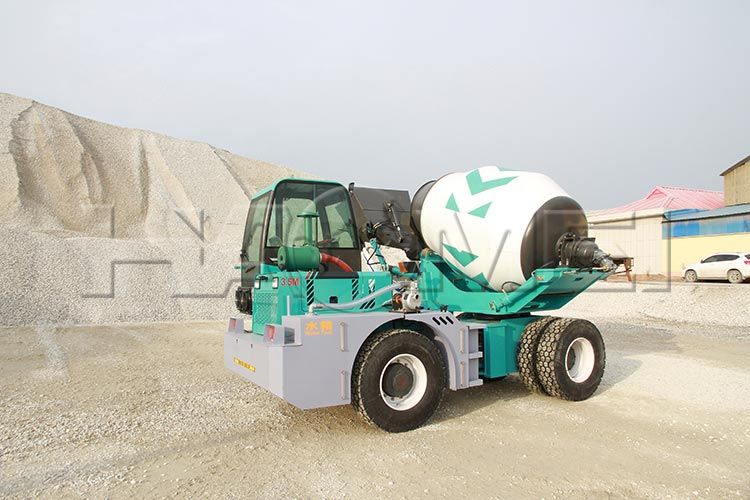Self Loading Pan Mixer VS Self Loading Concrete Mixer Truck
 2025-06-26
2025-06-26In the field of construction engineering, self loading concrete mixer trucks have become a powerful assistant for many construction projects due to their high efficiency and convenience. There are various types of self-loading concrete mixer trucks on the market. Today we focus on comparing two common types of mixer trucks and deeply analyze their differences, hoping to provide a strong reference for relevant practitioners when selecting equipment.

Self loading pan mixer
Structural design and working principle
The flat-mouth self-loading concrete mixer truck is unique in structure. Its mixing device usually adopts a flat-mouth forced mixing method, and the mixing blades rotate at high speed around the central axis to vigorously mix the materials. This mixing method can fully mix raw materials such as cement, aggregate, and water in a short time to ensure the uniformity and quality of concrete.
From the working principle, the power of the car chassis is obtained through the power take-off device to drive the hydraulic system, which in turn drives the mixing device to operate. During the mixing process, the material is forced to be squeezed, sheared and turned over by the blades in the mixing drum to achieve rapid and sufficient mixing.
Applicable scenarios
The self loading concrete mixers are suitable for a variety of scenarios. Due to its high mixing efficiency and ability to produce a large amount of concrete in a short period of time, it performs well in large-scale construction projects, such as urban commercial complex construction and large residential community development. Such projects have a large demand for concrete and the supply must be timely.
It is also very popular in road engineering construction, and can play its advantages in the construction of highways, urban trunk roads, and rural roads. When constructing in some remote areas or mountainous areas with complex terrain and inconvenient transportation, flat-mouth mixer trucks do not rely on external power facilities, but can operate independently with their own power system, effectively solving the problem of concrete supply.
Advantages and limitations
High-efficiency mixing is a highlight. On average, a tank of concrete can be mixed in about 5 minutes, which greatly improves construction efficiency. At the same time, this model has relatively low requirements for site conditions and can also operate flexibly in some narrow or undulating construction sites. However, flat-mouth self-loading concrete mixer trucks also have certain limitations. The volume of its mixing drum is relatively limited, and it is generally suitable for small and medium-sized concrete production needs.
Self loading concrete mixer truck
In terms of structural design, the feeding system of this type of mixer truck is more efficient. The bucket is usually large and has good loading performance. It can quickly scoop up aggregates such as sand and gravel and transport them to the mixing tank. The blade design inside the mixing tank has also been carefully considered. Through reasonable angles and layouts, the materials form a unique rolling and mixing path during the mixing process to ensure that the concrete is mixed evenly.
Applicable scenarios
It is often seen in rural house construction, construction of small water conservancy facilities (such as irrigation pools, dams, etc.), and village road hardening projects. In these projects, the demand for concrete is relatively small, but the flexibility and ease of operation of the equipment are required.
In some small-scale building renovation projects, such as the renovation of old residential areas and the renovation of small commercial shops, the self loading concrete mixer can also play an important role, providing the required concrete for construction conveniently and quickly.
Advantages and limitations
This model has outstanding advantages. The automatic loading function is very convenient, and its bucket design makes the loading process efficient and labor-saving. It can quickly load raw materials into the mixing tank, greatly shortening the preparatory time for concrete production.
The driver can clearly observe the mixing situation in the cab, which is convenient for timely adjustment of mixing parameters to ensure that the humidity and mixing quality of the concrete meet the requirements, effectively avoiding concrete quality problems caused by insufficient or excessive mixing.
Its mixing efficiency may be slightly lower than that of a flat mixer truck, and it may take longer to mix a tank of concrete. When faced with large-scale, high-intensity concrete production tasks, its production capacity may not be able to meet demand.
Original Source: https://www.self-loading-mixer.com/a/self-loading-pan-mixer-vs-self-loading-concrete-mixer-truck.html
Tags: self loading concrete mixer tuck
Prev: Which Is Better: Self Loading Mixer Truck or Concrete Mixer Truck
Next: What Will 4x4 Drive of Self Mixing Concrete Truck Bring
Send us a Message
Category
| HM1.2 Self Mixer |
| HM1.8 Self Mixer |
| HM2.0 Self Mixer |
| HM 2.6 Self Mixer |
| HM3.5 Self Mixer |
| HM4.0 Self Mixer |
| HM 5.5 Self Mixer |
| HM6.5 Self Mixer |
Relate Blogs
Relate Products
CONTACT US
| Haomei Self Loading Mixer Co.,Ltd |
| Tel/Whatsapp: +86-15978414719 |
| Email: feedom@haomei-machinery.com |
| Website: https://www.self-loading-mixer.com |
| Office Add: 1103, No.14 Outer Ring Road, CBD, Zhengzhou, China |





